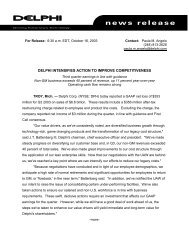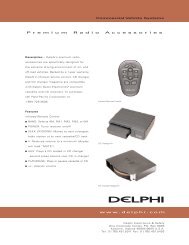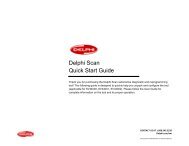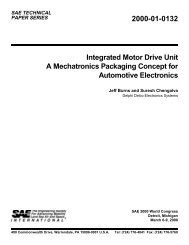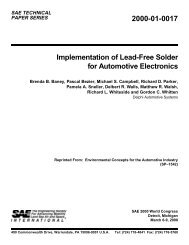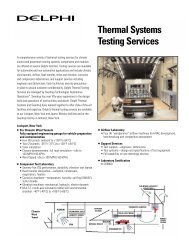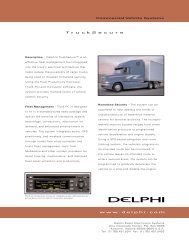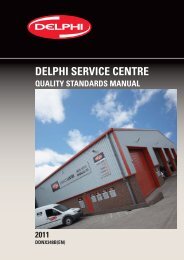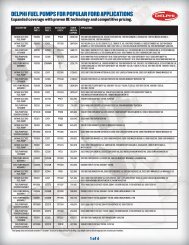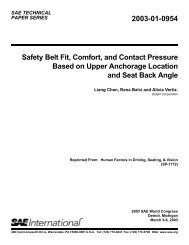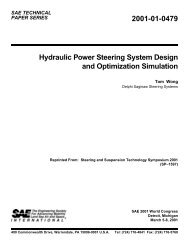2001-01-0595 A Model-Based Brake Pressure Estimation ... - Delphi
2001-01-0595 A Model-Based Brake Pressure Estimation ... - Delphi
2001-01-0595 A Model-Based Brake Pressure Estimation ... - Delphi
Create successful ePaper yourself
Turn your PDF publications into a flip-book with our unique Google optimized e-Paper software.
TCS <strong>Brake</strong> <strong>Pressure</strong> Estimate <strong>Model</strong><br />
1<br />
s<br />
Xp<br />
Displacement<br />
Vs. <strong>Pressure</strong><br />
Ps<br />
Pc<br />
Apply Command<br />
Apply<br />
Valve<br />
Release Command Release<br />
Valve<br />
Figure 3 SIMULINK diagram of one channel brake pressure estimation model for TCS<br />
From the results, it is apparent that the new model-based<br />
TCS brake pressure estimation gives fairly accurate brake<br />
pressure estimation. Since this algorithm is based on a<br />
physical model, it can predict brake pressure accurately<br />
over all testing conditions. And a big advantage of the<br />
proposed algorithm is the reduction of calibration time.<br />
CONCLUSION<br />
In this paper, a model-based brake pressure estimation<br />
algorithm for TCS is presented. The algorithm is simplified<br />
based on model analysis to enable production<br />
implementation. The pressure estimation algorithm is<br />
validated using vehicle data. The simulation results show<br />
that the new algorithm can predict brake pressure<br />
accurately for traction control systems, and is robust for<br />
all testing cases.<br />
In addition, there are fewer calibration variables that need<br />
to be determined from testing than in the current<br />
algorithm. This means significant savings in calibration<br />
time and cost. This algorithm more accurately estimates<br />
the pressure at the driven wheel allowing the brake control<br />
systems to depend more heavily on this estimation. The<br />
improved algorithm can reduce brake wear and improve<br />
driver comfort during an active brake control event.<br />
ACKNOWLEDGMENTS<br />
The authors acknowledge gratefully the technical support<br />
of Bryan T. Fulmer, Joseph A. Elliott of <strong>Delphi</strong> Technical<br />
Q1<br />
Q2<br />
1/ap<br />
Xp_dot<br />
Center Brighton and James R. Bond of <strong>Delphi</strong> Technical<br />
Center Dayton. Specially, for the discussion with Bryan T.<br />
Fulmer<br />
REFERENCES<br />
1. Paul, J., Klinkner, W., Muller, A., “Electronic stability<br />
program - the new active safety system of mercedesbenz”<br />
SAE 97-06 957128.<br />
2. “Automotive <strong>Brake</strong> Systems,” Robert Bosch GmbH,<br />
1995.<br />
3. Merritt, H.E., “Hydraulic Control Systems” John Wiley<br />
and Sons, Inc., 1967.<br />
4. Doebelin, E.O., “System Dynamics <strong>Model</strong>ing,<br />
Analysis, Simulation, Design” Marcel Dekker, Inc.,<br />
1998.<br />
CONTACT<br />
Qingyuan Li and Keith W. Beyer are systems engineers<br />
in Chassis Systems, and Quan Zheng is a Controls<br />
engineer in Forward Energy and Energy Management<br />
Systems at <strong>Delphi</strong> Automotive Systems, Technical Center<br />
Brighton, 125<strong>01</strong> E. Grand River, Brighton, MI 48116. Their<br />
contacting emails are as follows:<br />
qingyuan.li@delphiauto.com.<br />
keith.w.beyer@delphiauto.com.<br />
quan.zheng@delphiauto.com



